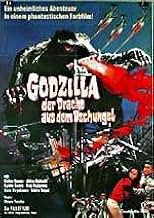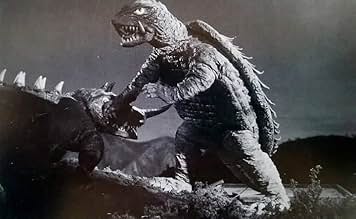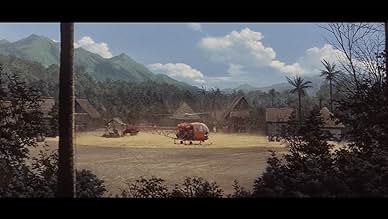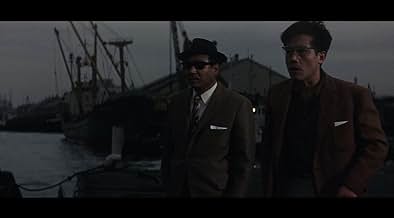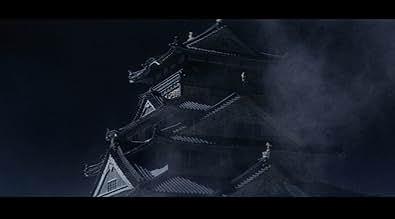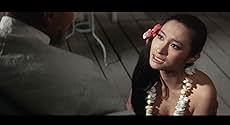VALUTAZIONE IMDb
5,1/10
3047
LA TUA VALUTAZIONE
Aggiungi una trama nella tua linguaA giant monster that emits a destructive ray from its back attacks Japan and takes on Gamera.A giant monster that emits a destructive ray from its back attacks Japan and takes on Gamera.A giant monster that emits a destructive ray from its back attacks Japan and takes on Gamera.
- Regia
- Sceneggiatura
- Star
Jutarô Kitashiro
- Self-Defense Force Commander
- (as Jutarô Hôjô)
Recensioni in evidenza
This probably is the most adult oriented of all the Gamera films mainly because it is the only film in the original series not to feature a child as the main human character. However, I also think that it is the one of the weaker films in the series. The human characters aren't really that interesting and this is one of the flaws of the Gamera series. At least with the Godzilla series (or for that matter Toho kaiju films altogether) the human characters, especially in the earlier films, are fully dimensional whereas in the Gamera films they are treated as more of an afterthought. This film is not really one of the brighter moments in the whole Gamera series.
This was the first color sequel to the original black and white GAMERA, and it's pretty good though you have to be patient in waiting to see much of our favorite fire-breathing, flying turtle. A new monster named Barugon (not to be confused with the similarly-named creature from the Toho series of Japanese giant monster movies) is born and has the ability to freeze people and cities. The monster suits in this series were never quite up to the ones in the Godzilla films, but the effects in general are not too bad. The real fun in this one is savoring the villainous exploits of one of the main human characters... a sneaky creep named Onodera. He steals the show as one of a group of men on an expedition to New Guinea to retrieve a glowing opal believed to be worth millions. There's a fight sequence between this guy and another man who can barely walk late in the movie that's better (and much funnier) than the monsters' battle! **1/2 out of ****
If you're a fan of Gamera from '90s trilogy, Gamera vs. Barugon may be the original Gamera movie for you.
The movie begins with Gamera's being freed from the rocket he was trapped in at the end of Gamera, the Gigantic Monster and returning to Earth to wreak havoc on a dam. He then disappears for a good 45 minutes while the movie follows a trio of treasure hunters to a tropical island on their quest to retrieve an opal the brother of one of the hunters hid in a cave during the Second World War. Not to give away too much, but the procurement of this opal leads to the emergence of Barugon, in the middle of Japan, who Gamera (eventually) fights in typical Gamera fashion.
Three things immediately stand out about the second entry in the Gamera series:
There are no kids in this movie. As in its predecessor, Gamera is apparently motivated purely by a quest for energy sources.
Gamera is barely in the movie. He opens the movie, returns to fight Barugon, then comes back after another long absence to fight Barugon again. The bulk of the movie deals with the birth of Barugon and the Japanese's attempts to defeat him. (Maybe this was the genesis of the military's conflict in Gamera: The Revenge of Iris over which monster to attack first.)
Finally, the movie is in color, and Daiei seems eager to exploit that fact. The opening titles are played out over shapeless colors, and one of Barugon's weapons is a rainbow beam emanating from his back.
The movie contains some silly moments (most notably the theft of the diamond), but the human conflicts and relationships are played surprisingly straight and adult, at least in comparison to those in a typical Godzilla movie; everyone doesn't necessarily agree on strategy, and it's probably safe to say the two leads don't view each other as siblings. The biggest problem with the movie is its odd pacing, but without a delusional kid and several characters who do virtually nothing running around, Gamera vs. Barugon is a decided improvement over the original.
The movie begins with Gamera's being freed from the rocket he was trapped in at the end of Gamera, the Gigantic Monster and returning to Earth to wreak havoc on a dam. He then disappears for a good 45 minutes while the movie follows a trio of treasure hunters to a tropical island on their quest to retrieve an opal the brother of one of the hunters hid in a cave during the Second World War. Not to give away too much, but the procurement of this opal leads to the emergence of Barugon, in the middle of Japan, who Gamera (eventually) fights in typical Gamera fashion.
Three things immediately stand out about the second entry in the Gamera series:
There are no kids in this movie. As in its predecessor, Gamera is apparently motivated purely by a quest for energy sources.
Gamera is barely in the movie. He opens the movie, returns to fight Barugon, then comes back after another long absence to fight Barugon again. The bulk of the movie deals with the birth of Barugon and the Japanese's attempts to defeat him. (Maybe this was the genesis of the military's conflict in Gamera: The Revenge of Iris over which monster to attack first.)
Finally, the movie is in color, and Daiei seems eager to exploit that fact. The opening titles are played out over shapeless colors, and one of Barugon's weapons is a rainbow beam emanating from his back.
The movie contains some silly moments (most notably the theft of the diamond), but the human conflicts and relationships are played surprisingly straight and adult, at least in comparison to those in a typical Godzilla movie; everyone doesn't necessarily agree on strategy, and it's probably safe to say the two leads don't view each other as siblings. The biggest problem with the movie is its odd pacing, but without a delusional kid and several characters who do virtually nothing running around, Gamera vs. Barugon is a decided improvement over the original.
I have to agree with the first comment and say that this is the best of pre-1995 the Gamera's. I've seen five of them, Guiron and Zigra both being indescribably bad (even when I watched them as a 13 year old I thought so). This one is honestly pretty good, a step-up from the stone age-looking Gamera, which was made in 1965 but looked like it was made in 1954! First off, there isn't too much flashback footage and when it is used, it's actually well-edited and has some pretty cool narration and atmospheric music. There's a random dam attack scene which I still cant figure out why it's there, and then the real story starts with the protagonists finding a jewel that eventually turns into the secondary monster.
Gamera plays a pretty minor second-fiddle this time around, with Barugon, an admittedly more interesting monster, hogging most of the screentime destroying things. I really liked the plotting with the greedy guy accidentally waking the monster with his heat-lamp, and then getting eaten when he ruins the army's plan by trying to steal a giant diamond.
This has the best music and best scenes of destruction of any of the Gamera movies and most of Jun Fukuda's Godzilla films. While it's still Daiei, which most of the time is sub-Toho in every respect, this film shows that around 1966 Daiei actually managed to surpass Toho every now and then effects-wise. Good directing too: the tone is surprisingly mature this time around and it's got a really dark and humorless undercurrent to the whole thing.
My favorite Gamera movie, followed by the... so unintentionally hilarious, it makes me crack up thinking about it... Gamera vs. Gaos.
Gamera plays a pretty minor second-fiddle this time around, with Barugon, an admittedly more interesting monster, hogging most of the screentime destroying things. I really liked the plotting with the greedy guy accidentally waking the monster with his heat-lamp, and then getting eaten when he ruins the army's plan by trying to steal a giant diamond.
This has the best music and best scenes of destruction of any of the Gamera movies and most of Jun Fukuda's Godzilla films. While it's still Daiei, which most of the time is sub-Toho in every respect, this film shows that around 1966 Daiei actually managed to surpass Toho every now and then effects-wise. Good directing too: the tone is surprisingly mature this time around and it's got a really dark and humorless undercurrent to the whole thing.
My favorite Gamera movie, followed by the... so unintentionally hilarious, it makes me crack up thinking about it... Gamera vs. Gaos.
Sequel to 'Gamera" finds that giant turtle returning to Japan after being freed from it's outer space imprisonment after a fortuitous collision with a meteor. Turns out this was serendipitous as well, since a giant monster called Barugon has emerged from a hatched egg brought back to Japan by a treacherous expedition member, who will come to a memorable end... Barugon can freeze things with its extended tongue, and Gamera has his hands full trying to defeat this menace. Not bad sequel made in color has lots of good action and an imaginative story, though plenty of elements to appeal to children as well. Gamera becomes an Earth defender here.
Lo sapevi?
- QuizThis is the only film in the original series to not feature a child as the main human character.
- BlooperEnglish language version: If Barugon's is harmed by water, how did he swim from the sunken ship to the shore without any difficulty? The translation neglects to mention that while he's vulnerable to water, it doesn't immediately kill him, just weakens him. It has also been suggested that salt water doesn't harm him as much as fresh water.
- Versioni alternativeThe Japanese version runs a complete 101 minutes. The American International Pictures-TV (A.I.P.-TV) release version, under the title WAR OF THE MONSTERS, was cut down to 88 minutes to fit it's televised playdates. The 14 minutes that were removed were only expository scenes that had the characters discuss how to destroy the monster Barugon.
- ConnessioniFeatured in Il mostro invincibile (1968)
I più visti
Accedi per valutare e creare un elenco di titoli salvati per ottenere consigli personalizzati
Dettagli
- Tempo di esecuzione
- 1h 46min(106 min)
- Mix di suoni
- Proporzioni
- 2.35 : 1
Contribuisci a questa pagina
Suggerisci una modifica o aggiungi i contenuti mancanti

